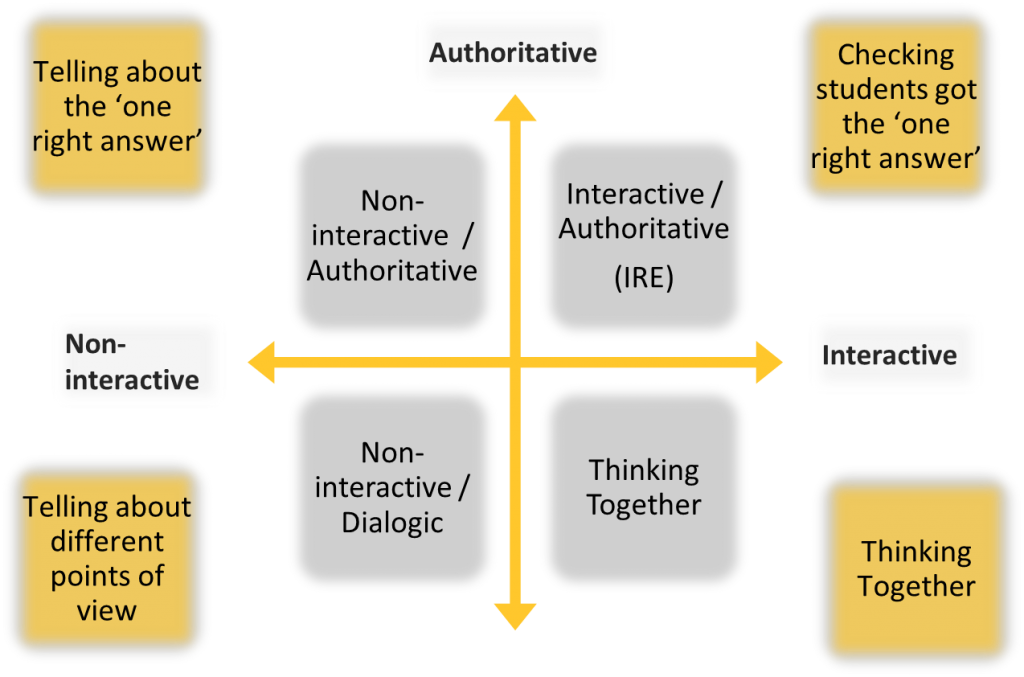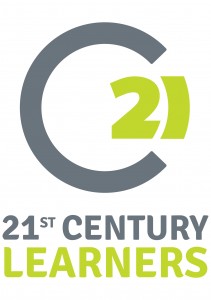A Teacher’s Guide to Dialogic Pedagogy Part 2: The How – Getting Started

Introduction
In the previous post I described dialogic pedagogy as involving teachers and students talking and thinking in a way that seeks out and values different perspectives, and uses them to develop understanding. The broad term ‘dialogic pedagogy’ encompasses diverse approaches to its enactment in the classroom. Notable approaches include Professor Robin Alexander’s Dialogic Teaching; Thinking Together as developed by Professor Rupert Wegerif, Professor Neil Mercer and Dr Lyn Dawes; Professor Lauren Resnick’s Accountable Talk; Roger Sutcliffe’s Philosophical Teaching and Philosophy for Children (P4C) as developed by Professor Matthew Lipman. Follow the links or see the bibliography to find out more about them.
My own classroom approach, outlined in this and subsequent posts, is in reality a synthesis of those listed above. I refer to it as Thinking Together as it has largely grown out of my writing with Rupert Wegerif in which we have re-visited the Thinking Together approach, though it is also connected closely to my experience with P4C. I am certainly indebted to all those listed, especially Wegerif, Sutlcliffe and Mercer who I am fortunate enough to have worked with.
Types of Teacher Talk
One way to get started is to consider the different types of talk used in your classroom / school. This can involve both student talk and teacher talk, in small groups and as a whole-class. Let’s focus first on teacher talk. From the outset I want to be clear that dialogue is not the only type of talk valuable to teaching and learning. I remember the fashionable saying that a teacher should be ‘a guide on the side, not a sage on the stage’. I don’t agree. Teaching is a complex business and must make use of various ways of communicating; there is a place for ‘telling’ and there is a place for dialogue.
Robin Alexander provides a more nuanced ‘repertoire’ of teacher talk types comprised of rote, recitation, instruction, exposition, discussion, deliberation, argumentation and dialogue (though he suggests that discussion, deliberation and argumentation can be a part of dialogue). Another helpful (and somewhat simpler) taxonomy is provided by Eduardo Mortimer and Philip Scott in their 2003 book ‘Making Meaning in Secondary Science Classrooms’.
Like Alexander, Mortimer and Scott acknowledge that teachers – legitimately – use different talk-based approaches to develop ideas with their students. They refer to these as different ‘communicative approaches’, and offer four categories of communicative approach based on two dimensions. The first of these considers where the talk lies on a scale from dialogic to authoritative:
- Dialogic: Attention is paid to more than one perspective; different perspectives are held in tension together
- Authoritative: Attention is focused on just one point of view – usually that of the teacher or the discipline
The second dimension considers where the talk lies on a scale from interactive to non-interactive:
- Interactive: Talk allows for the participation of different people (including students)
- Non-interactive: The teacher talks and other people (the students) are excluded / listen
The diagram below shows how these dimensions give us four categories of talk (the simpler descriptions in the yellow boxes are mine):

Let’s consider each category in turn:
Authoritative / Non-interactive (or telling about the one right answer). Perhaps the most obvious example of this is lecturing, which might involve instructing, explaining, describing and demonstrating in order to convey information to the students (about a concept or a procedure, for example) without requiring them to speak.
Authoritative / Interactive (or checking that the students got / leading students to the one right answer). This is an important one, because it is ubiquitous. It’s easy to imagine that whenever we are verbally interacting with students we are being dialogic. Perhaps this notion can most easily be challenged by considering the well-known ‘IRE’ (Initiation-Response-Evaluation) pattern of teacher-student interaction. Consider the brief exchange below:
T: So we can only see the moon because the light from the sun does what?
S1: Passes through it, sir
T: No
S2: Bounces off it, sir
T: Bounces – reflects off it – yes, well done, that’s right
Here the teacher initiates the exchange with a question. The question is closed in the sense that the teacher already has a single right answer in mind; the intention in this case is to check whether the students have grasped the answer – are they able to recite what has been taught? The question provokes brief responses. Rather than opening up wrong answers to reveal what they might show about the state of the students’ learning, the teacher dismisses them; s/he is only interested in the right answer. This, once given, is re-enforced through the teacher’s approval – in other words the teacher quickly evaluates student responses. This type of exchange is also common in rhetorical sequences in which a teacher has already determined the end point of the exchange and questions are designed to elicit the desired answer that allows the teacher to make his or her point.
Dialogic / Non-interactive (or telling about different points of view). In this case the teacher is doing all the talking, but s/he acknowledges different perspectives and holds them in tension, perhaps engaging in a one-person dialogue (remember that ‘dia’ does not mean ‘two’, but rather ‘through’ or ‘across’. You can reason through or across different perspectives on your own). A teacher might explore different interpretations of a poem, an historical event or a set of data, or s/he might make reference to the views expressed by students as s/he explains his or her own point of view.
Dialogic / Interactive (or thinking together). Consider the transcript below (based on a conversation about an image from Armin Greder’s ‘The Island’):
T: Look at the image. What do you notice?
S1: Her eyes and how wide they are, miss.
T: Why are her eyes worth noticing – what might they tells us?
S1: She’s scared – well, terrified.
T: Go on…
S1: She’s scared because she’s seen the man and she thinks he might hurt her.
T: Would anyone like to say more about that?
S2: I don’t think she’s scared, I think she’s shocked ‘cos the man looks so bad ‘cos they starved him.
In this case the question is an open one – there is no one right answer available. The teacher shows interest in and value for the students’ contributions, and rather than evaluating them, s/he opens them up to further exploration. Instead of an IRE pattern, we have an IRFRFRF pattern, where F stands for ‘feedback’ – a contribution from the teacher (or even better another student) that doesn’t close the exchange, but opens it up.
It is possible to do this with closed questions too. Look at the extended transcript shared here. The teacher – me – is working towards getting Student 1 to see the ‘scientific point of view’, and yet refrains for a good time from an authoritative explanation. Can this be recognised as thinking together? Is it of value? It’s important to note that in this example the teacher has an ‘accountability to accurate subject knowledge‘ (here I borrow a phrase from Accountable Talk); the dialogic interaction plays an important role in helping the student to re-construct her understanding, but of course she can’t be ‘made’ to accept the teacher’s perspective. However, the teacher has a responsibility to reiterate the scientific definition of freezing, perhaps using an authoritative / non-interactive communicative approach (or preferably a dialogic non-interactive approach that connects to the students’ views).
In both these examples we are giving the students the opportunity to reflect, to question, to make connections and to make meaning. Such episodes also provide teachers with vital feedback about the learning that is taking place. It’s easy to see how thinking together might complement a more authoritative input; you know what you tried to ‘teach’, but is that what has been ‘learned’?
An important message here is that all of these approaches have a role to play. Careful expositions by teachers are undoubtedly valuable, and the use of IRE routines to re-inforce key learning is important. And of course teachers may switch from one communicative approach to the next in a fluent and effective way during a single teaching and learning episode. BUT –researchers tell us that they see relatively little dialogic / interactive teaching. Authoritative / interactive teaching, characterised by the IRE routine, remains dominant.
Some Practical Suggestions
The task, then (assuming that one accepts the value of dialogic pedagogy as outlined in the previous post), is not to put an end to lecturing and rhetorical questioning, but to increase the proportion of dialogic / interactive communication in the ‘mix’ of teacher talk – to encourage more thinking together.
One starting point is to become more aware of the different communicative approaches you use, the extent to which you use each one, and the purposes for which each is useful. Here are some things to try:
- Read the descriptions of the four communicative approaches again. Reflect on your teaching – can you identify examples of your use of each one? Which do you use most often – what’s your gut feeling?
- Share the descriptions with a colleague – a teaching assistant or someone interested in working with you to introduce Thinking Together. Ask them to observe one or two of your lessons and record the different approaches you use. As you reflect on the session together, can you see a correlation between the approach you use and your teaching purpose? Were you using the communicative approach most suited to what you were trying to achieve? You could also record your teaching to support this kind of reflection.
- Repeat the exercise for a different subject (if you teach more than one). Does the nature of the subject influence the mix of communicative approaches you use?
- Download this checklist of teacher behaviours associated with dialogic pedagogy (it’s not comprehensive or authoritative!). Ask a colleague to make a note of which behaviours they see and which they don’t (and by all means edit the list).
- As you plan a lesson, think about the different communicative approaches you might use in different teaching episodes. Would it be useful to use a Thinking Together approach at any point? Why?
In the next post we’ll look at ways in which a teacher can plan for an episode of Thinking Together. We’ll discuss the ‘shift’ the teacher makes from a mode of ‘putting in’ to a mode of facilitating dialogue. We’ll think about how the classroom layout affects communicative approach and share some approaches to questioning that will support teachers to draw their students into dialogue.
Bibliography
Alexander, R. 2020, A Dialogic Teaching Companion, Routledge, Abingdon
Dawes, L., Mercer, N. and Wegerif, R., 2000, Thinking Together, a programme of activities for developing speaking, listening and thinking skills for children aged 8-11, Imaginative Minds Ltd. , Birmingham
Mortimer, M. and Scott, P. H., 2003, Meaning Making in Secondary Science Classrooms, Open University Press, Maidenhead
Phillipson, N. and Wegerif, R. 2017, Dialogic Education: Mastering core concepts through thinking together, Routledge, Abingdon
Tags: classroom talk, dialogic pedagogy, dialogic teaching, dialogue


